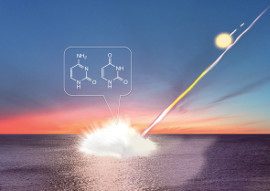Meteorite Impacts Can Create DNA Building Blocks

Figure 1: Schematics of nucleobases formation by meteorite impact on earth. Copyright : Tohoku University, National Institute for Materials Science (NIMS) and Hiroshima University
A new study shown that meteorite impacts on ancient oceans may have created nucleobases and amino acids. Researchers from Tohoku University, National Institute for Materials Science (NIMS) and Hiroshima University discovered this after conducting impact experiments simulating a meteorite hitting an ancient ocean (Fig. 1 and 2).
With precise analysis of the products recovered after impacts, the team found the formation of nucleobases and amino acids from inorganic compounds. The research is reported this week in the journal Earth and Planetary Science Letters.
All the genetic information of modern life is stored in DNA as sequences of nucleobases. However, formation of nucleobases from inorganic compounds available on prebiotic Earth had been considered to be difficult.
In 2009, this team reported the formation of the simplest amino acid, glycine, by simulating meteorite impacts. This time, they replaced the carbon source with bicarbonate and conducted hypervelocity impact experiments at 1 km/s using a single stage propellant gun (Figure 2).
They found the formation of a far larger variety of life’s building blocks, including two kinds of nucleobases and nine kinds of proteinogenic amino acids. The results suggest a new route for how genetic molecules may have first formed on Earth.
Associated links
Original article by NIMS
Media Contact
More Information:
http://www.researchsea.comAll latest news from the category: Materials Sciences
Materials management deals with the research, development, manufacturing and processing of raw and industrial materials. Key aspects here are biological and medical issues, which play an increasingly important role in this field.
innovations-report offers in-depth articles related to the development and application of materials and the structure and properties of new materials.
Newest articles

First-of-its-kind study uses remote sensing to monitor plastic debris in rivers and lakes
Remote sensing creates a cost-effective solution to monitoring plastic pollution. A first-of-its-kind study from researchers at the University of Minnesota Twin Cities shows how remote sensing can help monitor and…

Laser-based artificial neuron mimics nerve cell functions at lightning speed
With a processing speed a billion times faster than nature, chip-based laser neuron could help advance AI tasks such as pattern recognition and sequence prediction. Researchers have developed a laser-based…

Optimising the processing of plastic waste
Just one look in the yellow bin reveals a colourful jumble of different types of plastic. However, the purer and more uniform plastic waste is, the easier it is to…



